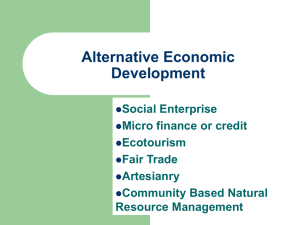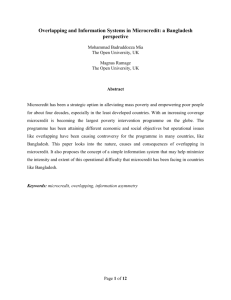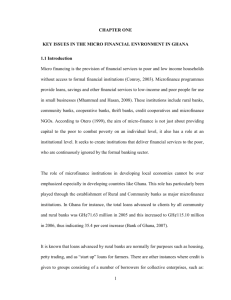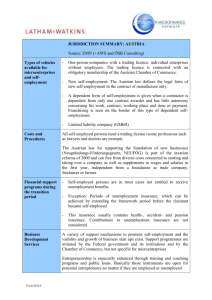Lecture 3
advertisement
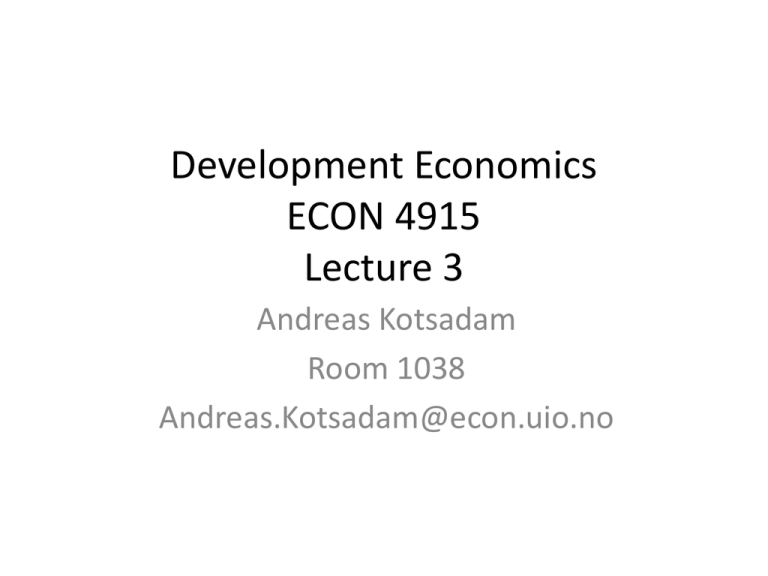
Development Economics ECON 4915 Lecture 3 Andreas Kotsadam Room 1038 Andreas.Kotsadam@econ.uio.no Outline • • • • • • Class assistants Updated reading plan Possible exam question and recap Microcredit (Banarjee and Duflo 2010) A new microcredit experiment A detour on risk (for next lecture) Updated reading plan • • • • • • • • • • Lectures 1-2: Introduction and rural credit markets Ray Ch. 14, pages 529-558. Lecture3: Credit markets for the poor, what do we know? Burgess and Pande; Banarjee and Duflo Lecture 4: Insurance Ray Ch. 15, pages 591-607. Lecture 5 Empirical methods in development economics Duflo et al. (pages 1-14 and 66-75) ; Imbens Lecture 6: The curse of natural resources Frankel; Mehlum et al. Typical exam question • 2a) Give some arguments for and against the idea that a state led expansion of rural banks should reduce poverty (2 points). • 2b) If we are interested in the effects of rural banks on poverty, why is it a bad idea to draw conclusions by simply comparing poverty in areas that have banks to poverty in areas that do not have banks? (1 point) Typical exam question • 2c) Burgess and Pande (2005) instead use a policy rule in India between 1977 and 1990 that forced banks who wanted to open in a location that already had banks to open banks in four areas that had no banks. In particular, they exploit the trend reversals between 1977 and 1990 and between 1990 and 2000 (relative to the 19611977 trend) in the relationship between a state's initial financial development and rural branch expansion as instruments for branch openings in rural unbanked locations. What arguments are provided for using these instruments? (4 points) Typical exam question • 2d) What are their conclusion and how can it be criticized? (3 points) Their conclusion • “We provide robust evidence that opening branches in rural unbanked locations in India was associated with reduction in rural poverty.” Critical questions • Have they really showed that rural banks matter or just that this policy had effects? • Does it matter that the bank openings were not randomly assigned? • Is the result generalizable to other contexts? • Do we know why the reform had an effect? • What about the long term effects? (See Fulford 2011, “The effects of financial development in the short and long run”, Boston College Working Paper.) • Was it cost effective? Microcredit: Miracle or just a hype? • A typical narrative... Illuminating book What is microcredit? • Wikipedia: ”Microcredit is the extension of very small loans (microloans) to those in poverty designed to spur entrepreneurship.” • Ray: ”Small-scale lending.” • B&D: ”Innovations that lower the administrative cost of making small loans.” Banarjee and Duflo (2010) • Overview paper. • A good read that covers the basic ideas about the credit problems we discussed. • A crucial read for the discussion of microcredits. Banarjee and Duflo (2010) • How can we explain the success of the microcredit movement? • Basic argument: Administrative costs are reduced. • What part of the package matters and what can we learn from behavioral economics? Some innovations and mechanisms • • • • • Dynamic incentives. Group liability. Repayment frequency and social interactions. Simplified collection technology. Temptation and self-control. Dynamic incentives. • Default implies a lost opportunity of larger loans in the future. • Theoretically, dynamic incentives cannot work alone… • … and competition may undermine the dynamic incentives. Group liability. • Default by one member hurts the other members. • This should make clients invest in screening and monitoring. • But the drawback may be too little risk-taking. • Empirical evidence suggests joint liability is not the driving factor. Repayment frequency and social interactions. • Weekly repayment is the typical time period. • Evidence suggest that longer time periods are better for investment… • …but worse for default. • Compatible with a social capital story, which actually recieves empirical support. Simplified collection technology. • The costs of collecting the loans are very low. • Loan officers are able to collect payments from many people each day and it becomes very easy. Temptation and self-control. • What if borrowers have self control problems? Wouldn’t easy credit make this worse? • It actually seems to be the other way around: microcredit helps people commit to a savings plan. • But is it the best way to achieve commitment? The Mongolian Microfinance Experiment • Attanasio et al. (2012). Taken from the development impact blog. • Sample: 1148 women in 40 villages in rural Mongolia. • Loans: intended for business use, but about a half are used for household uses. Interested people sign up beforehand. • Intervention: Villages were randomized so that 15 got group loans, 15 got individual loans, and in 10 no loans were provided. Data • A baseline survey was taken before people were assigned to treatment and control groups. • Follow-up survey 18 months after baseline. Results • Individual and group loans are used in similar ways. In both treatments women report using just over half of the loans for business uses. • There is no difference in default probabilities between the two types of loans. • They find a large impact of group loans on the probability of individuals owning an enterprise. Results • Food consumption increased in the group villages and there is reduction in amounts spent on cigarettes (a temptation good). • In both individual and group loans there is an increase in purchases of large household appliances. Conclusion • “Group discipline may not only prevent the selection of overly risky investment projects, it may also ensure that a substantial part of the loans is actually invested in the first place (instead of used for consumption or transfers to others)”. Issues • Generalizability. • Heterogeneity. • Longer term effects. To sum up. • Microcredit is more than just a hype. • It is clearly one of the key instruments in the fight against poverty. • But it is probably oversold. • There is no indication of that it transforms whole societies and it is definitely not always the best tool. The research frontier • What aspects of microcredit can be amended to increase its popularity and flexibility while still having low costs? • How to finance larger businesses? • Microsavings and microinsurance. A detour on risk • 2 scenarios: 100 kr with p=0.5 or 50 kr with p=1. • EV= Expected value = average payoff • CE= Certainty equivalent = Amount accepted instead of the bet. • Risk premium= EV-CE Risk attitudes • A person is said to be: Risk neutral - if she is indifferent between the bet and a certain 50 kr payment. Risk averse - if she would accept a certain payment of less than 50 rather than taking the gamble. Risk loving - if the guaranteed payment must be more than 50 to induce her to take the guaranteed option. Expected utility theory and risk aversion • Expected utility of wealth: • E(u(w)) = (u(0) + u(100)) / 2 • An agent possesses risk aversion if and only if the utility function is concave. • E(U(W)) - Expected value of the utility (expected utility) of the uncertain payment. • E(W) - Expected value of the uncertain payment. • U(CE) - Utility of the certainty equivalent. • U(E(W)) - Utility of the expected value of the uncertain payment Risk aversion Risk neutrality Risk loving

